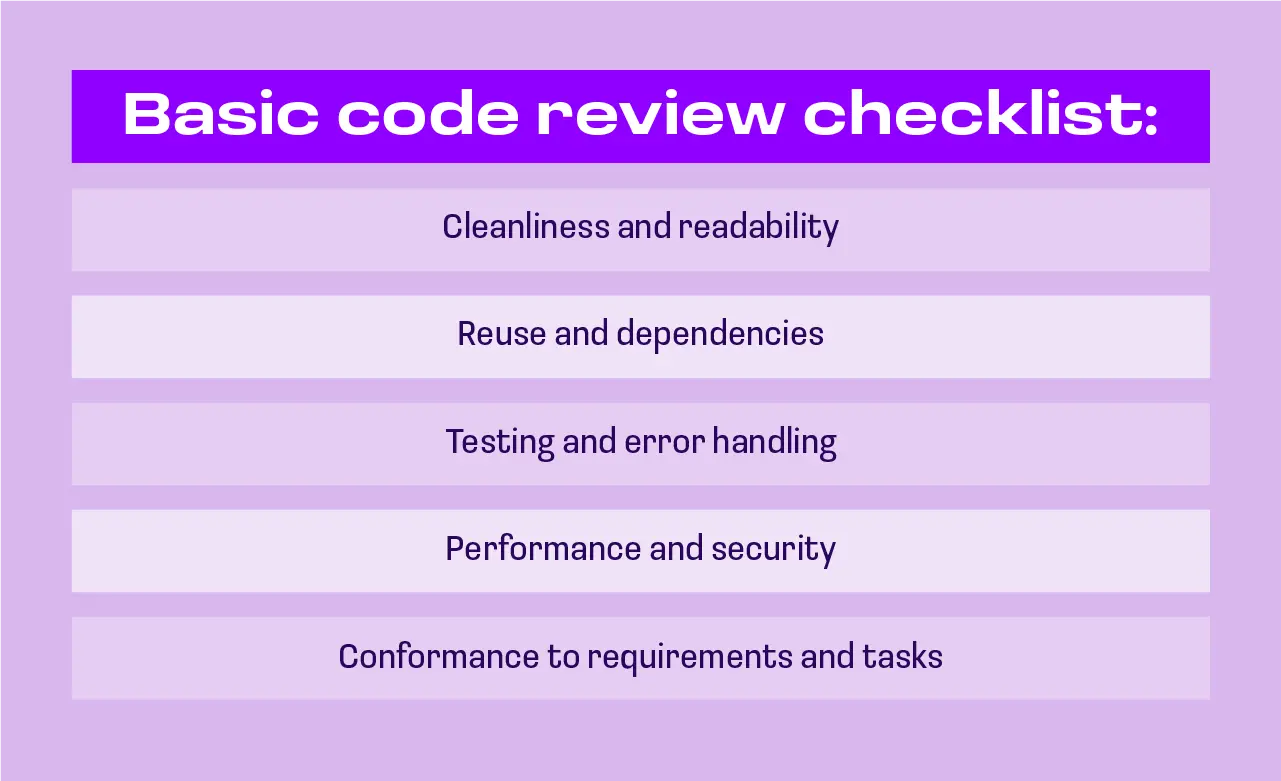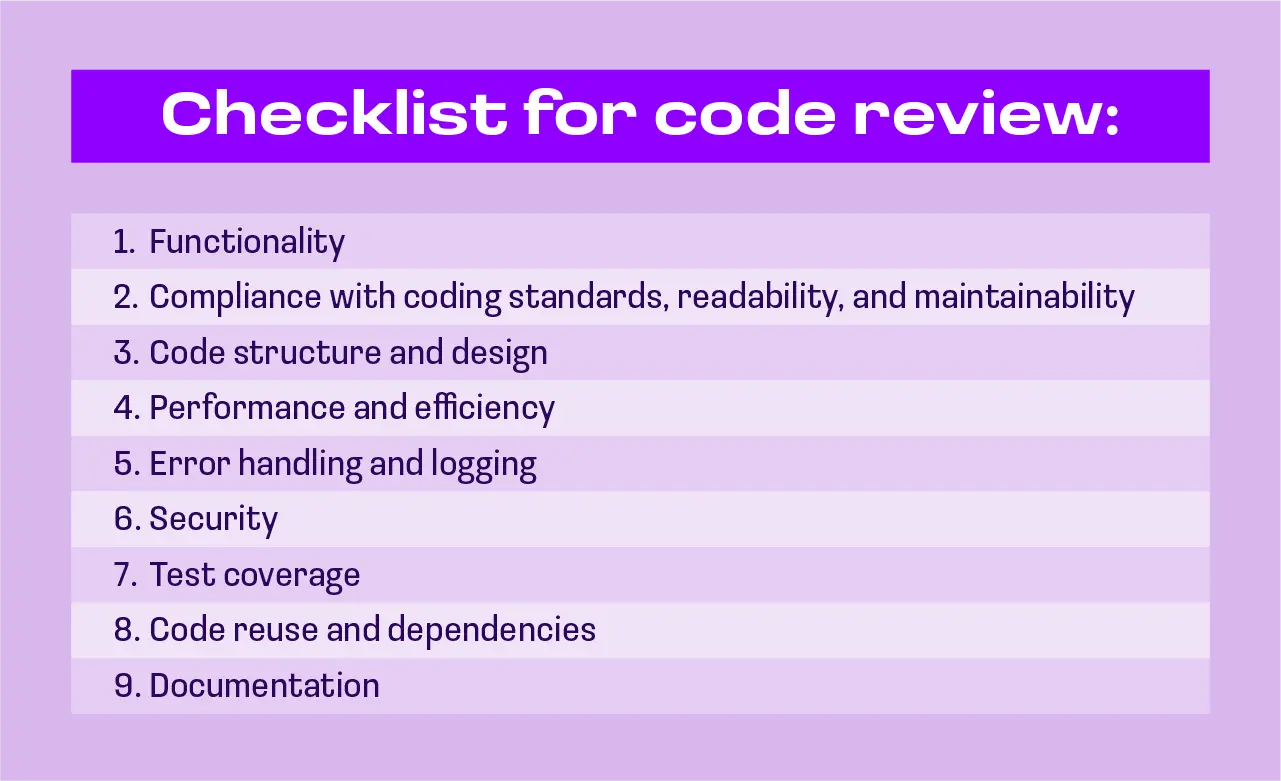Creating a Code Review Checklist: A How-To Guide
The author of this article is tech expert Pieter Murphy. Invited expert — Vitali Vishneuski, Delivery Manager, EngX Expert.

According to best practices and the need to ensure the code works as expected, developers often check each other’s work before merging it with the primary codebase.
This process is called Code Review. And sometimes, it includes a checklist. What is it? I asked Vitali Vishneuski, Delivery Manager and EngX expert, to help me best define a Code Review Checklist:
“In the most common case a Code Review is a peer-based checking of code to ensure it works and is of high quality before merging with the main codebase.
As such, it comes up with a list of what to check. This list serves as criteria to ensure developers meet certain standards of quality and maintainability before merging with the main codebase. We call this the Code Review Checklist.
It can be a shared or personal list, but it always must be consistent with principles, conventions and standards agreed within the team/project/product/company.”
So, a Code Review Checklist (CRC) is a set of rules which reviewers follow during review, among other aspects we discuss below.
Would you like to know more? Join me as we explore the topic.
Reasons to Use a Code Review Checklist?
Figuring out why a checklist for code review is important is all about looking at what most/recommended checklists focus on.
Here are some of the reasons developers implement and use checklists to review code:
1. Streamlining the process
Reviews can be hectic, depending on the size of the team and the complexity of the submitted work. Checklists make it easy to provide developers with a clear methodology for reviewing code, cutting down on time spent.
2. Resource optimization
Organizations like to save resources, especially through efficient processes. A code review checklist streamlines the process, ensuring a review is not costly or time-consuming.
3. Consistency in reviews
Checklists ensure that code is evaluated using the same standards. That ensures uniformity in coding practices and quality, no matter which team member is tasked with writing it.
4. Efficient onboarding
A checklist can offer new team members insight into how a team they are joining does code reviews and expectations, speeding up the integration process.
5. Objective evaluation
Using checklists is a recommended way to reduce subjective biases developers may have by providing clear and objective criteria for assessment, ensuring feedback is balanced and fair.
6. Knowledge transfer
As part of Agile methodologies of development, checklists can be used to teach developers best practices, point out common pitfalls, and promote continuous improvement, in a repeatable manner.
Vitali points out that in addition to making review easier, one of the main reasons we have checklists is to “make code review a consistent and predictable process,” adding that developers “groom our work to be consistent with the solution before integrating.”
“A checklist makes reviewing more accessible, but is not a motivation to apply it,” he emphasizes.
Basic Code Review Checklist
At the bare minimum, you need a basic code review checklist that covers the most important checks:
Cleanliness and readability. Ensure your work is well-structured, understandable, properly documented, and follows common style rules.
Reuse and dependencies. Pay attention to duplication and common dependency issues.
Testing and error handling. Verify the presence of functioning, adequate tests and correct error handling.
Performance and security. Assess whether your adversely affects the system's performance and does not contain potential security threats.
Conformance to requirements and tasks. Check if the code meets the goals and requirements stated in the specification or described ticket.

I asked Vitali to tell me a little about the process at the beginning of his professional career, which has spanned over two decades, and whether he had to use a ready-made review checklist.
Here’s what he had to say; “No, because I started my career in 1999. Kent Ben published his Extreme Programming Explained in October 1999. I met with XP, including Code Review, some years later. Then it was Clean Code: A Handbook of Agile Software Craftsmanship by Robert C. Martin in the 2010s. Checklists came later.”
As due diligence and best practices have become standardized, checklists are not just easy to come by, but developers all have in-house workflows that take into account reviews.
The Ultimate Topics To Consider For a Code Review Checklist
While the most comprehensive ultimate lists have almost everything you can think of, realistically speaking, most organizations needing code review checklists can only afford to focus on the most pertinent aspects of the process.
My ultimate checklist highlights the most critical, indispensable checks you must complete during your code review process to release it confidently. It includes more than the basic checklist and goes deeper into the process.
Vitali disagreed with me that a checklist is crucial to the process. As he put it, “It’s just reading code!”
Without further ado, here is the checklist.
1. Functionality
Check that the code does what it is supposed to do in implementation. Verify that it meets the project's specified requirements. Common questions used to assess functionality include:
1.1. Have all the requirements been met?
1.2. Are there any edge cases and potential error scenarios your new addition can’t handle?
1.3. Does your work align with the project’s specifications?
2. Compliance with Coding Standards, Readability, and Maintainability
Ensure that what you submit adheres to the established coding conventions. Verify that it is properly formatted, well-organized, and easy to read.
Consistent naming conventions and structured indentation contribute to a logically structured, readable, and easily skimmable codebase. Including comments is essential for helping colleagues understand the purpose and functionality of the code, particularly in more complex sections.
Compliance with coding standards is crucial for maintaining the integrity and quality of a codebase. A checklist-based review process, whether set by an organization or customized for a specific project, provides a unified framework for developers to follow.
Adhering to these standards not only ensures a thorough review but also minimizes the potential for errors in the codebase.
Maintainability is another critical aspect. Code that is easy to understand, well-documented, and consistently structured is far easier to maintain over time.
This reduces the effort required for future updates, bug fixes, and feature additions, ultimately extending the lifespan of the software and making it more adaptable to changing requirements.
By focusing on maintainability, you ensure the result remains accessible and manageable for both current and future developers.
3. Code Structure and Design
Check whether your work follows the established architectural guidelines and design patterns. Verify that the functions and classes are of reasonable size and complexity. A code quality review checklist allows developers to ensure what they write is modular and maintainable.
Checking the architecture involves answering questions like:
3.1. Modularity and separation of concerns
3.2. Are the pertinent parameters configurable?
3.3. Scalability
3.4. Maintainability
3.5. Dependency management
3.6. Interoperability
3.7. Error handling
Reviewing code design and structure emphasizing security, configurability, and feature management is a great way for developers to assess the architecture's robustness and flexibility, find potential risks or shortcomings, and make informed decisions to improve the code's maintainability.
4. Performance and Efficiency
Check for any unnecessary loops, suboptimal algorithms, or memory leaks that might hinder its performance. Questions to focus on performance and efficiency include:
4.1. Are the data structures and algorithms used appropriate and efficient?
4.2. Are there any potential performance bottlenecks?
4.3. I/O operations
4.4. Concurrency and parallelism
4.5. Lazy loading and initialization
4.6. Resource management
5. Error Handling and Logging
Review the code to ensure proper handling of errors and logging mechanisms. Proper error-handling methods ensure faster testing, troubleshooting, and easy identification of bugs when debugging the code.
6. Security
Security is crucial in all stages of the development process. Processes should have audits and testing around security. Security concerns should be addressed to ensure proper protection against SQL injections, denial of service attacks, or unauthorized access to sensitive data. Key considerations include:
6.1. Finding out if there are any data leaks
6.2. Finding out if any coding patterns may make the application vulnerable to threats.
7. Test Coverage
Ensure that unit, integration, and system tests cover the essential edge cases and functionality. Focus on the following key areas:
7.1. Are the tests passing, and are they up to date?
7.2. Test types.
7.3. Test execution.
7.4. Test independence
7.5. Coverage gaps
8. Code Reuse and Dependencies
Check that the code properly reuses the existing libraries, components, and frameworks. Confirm that all dependencies are managed correctly and updated. Verify that all unnecessary dependencies have been removed.
9. Documentation
Check that the code includes proper documentation with inline comments and method descriptions. High-level documentation is required for complex or bigger projects. Ensure the documentation is updated accordingly and in line with any system requirement changes.

Vitali emphasizes key points, asserting the significance of “code cleanliness and readability.” He highlights that poorly structured and complicated work challenges maintenance and future extension.
Additionally, he underscores the importance of testing, particularly unit testing, in providing self-explanatory results. This approach significantly simplifies the process of refactoring.
Vitali V.’s insights resonate strongly, aligning with the best practices in development and maintenance.
Create Your Own Review Checklist While Studying at EngX Code Review course
Developers can access courses that will prepare them to become efficient, reliable, and valuable members of any team they are a part of.
To hone your skills as a reviewer, you can get access to this EngX Code Review course to elevate your code quality.
By the end of the unit, you will be able to:
Self-evaluate your review skills and identify room for improvement.
Expand your knowledge of review processes
Implement what you’ve learned in practical settings
Maximize the benefits of the course for personal, team-based, and organizational development.
The course covers review fundamentals, how to set up and implement a review process (including resources to create a code review template you can use just about anywhere), as well as review best practices.
At the end, you can create a checklist on your own. Vitali V. is keen to point out that students of the course won’t “necessarily need to create their own checklists even though they will be prepared to do so if needed.”
Instead, “they will become acquainted with the general principles of code review, have a basic code review checklist template readily accessible, and be prepared to discuss the review process, including standards, conventions, and checklists, with their teammates on projects.”
Want to know more about Code Review best practices? Watch this video: Code Review Best Practices for Software Engineers.
Enjoy the EngX Clean Code course to write clean, maintainable code for faster development and reduced errors.


.png)
